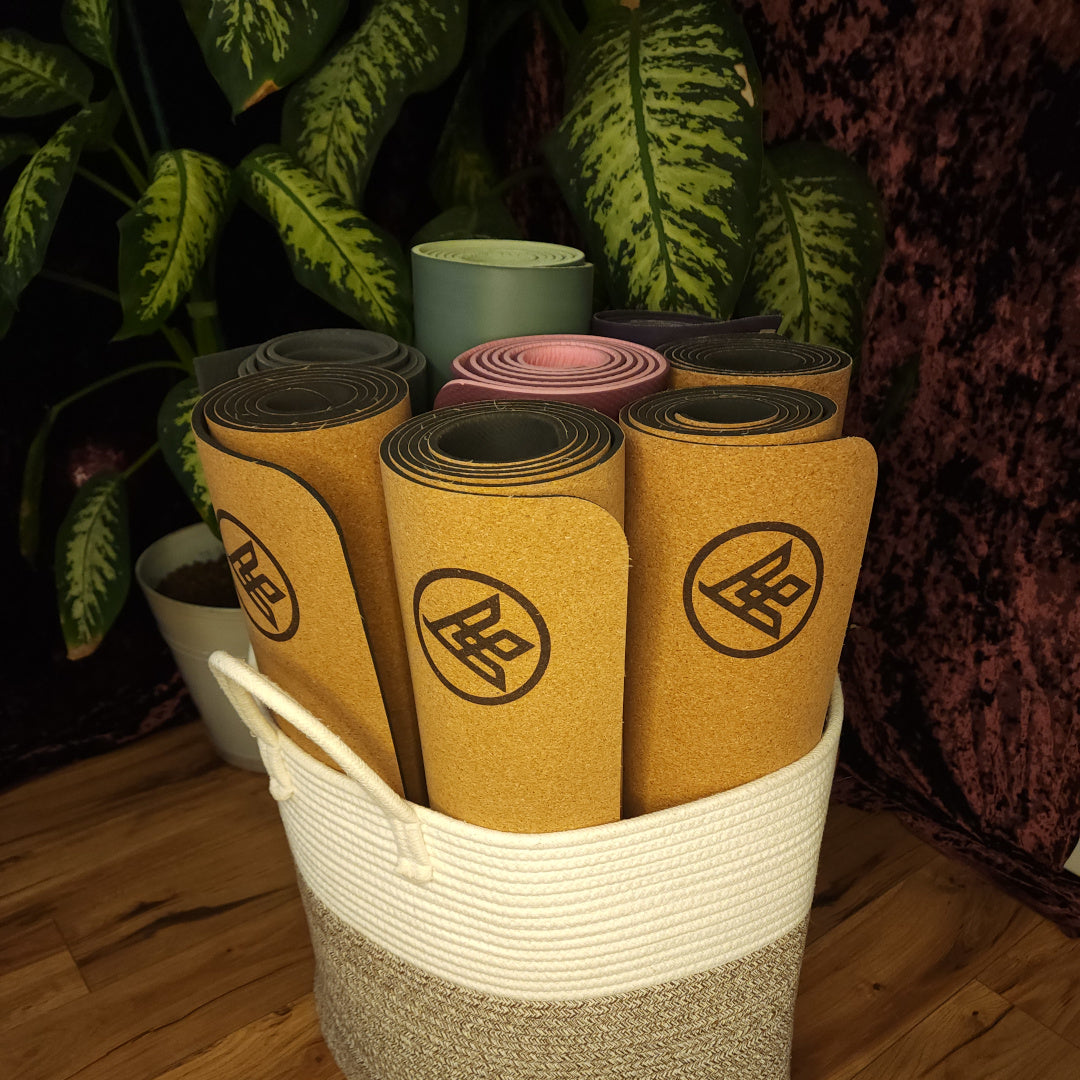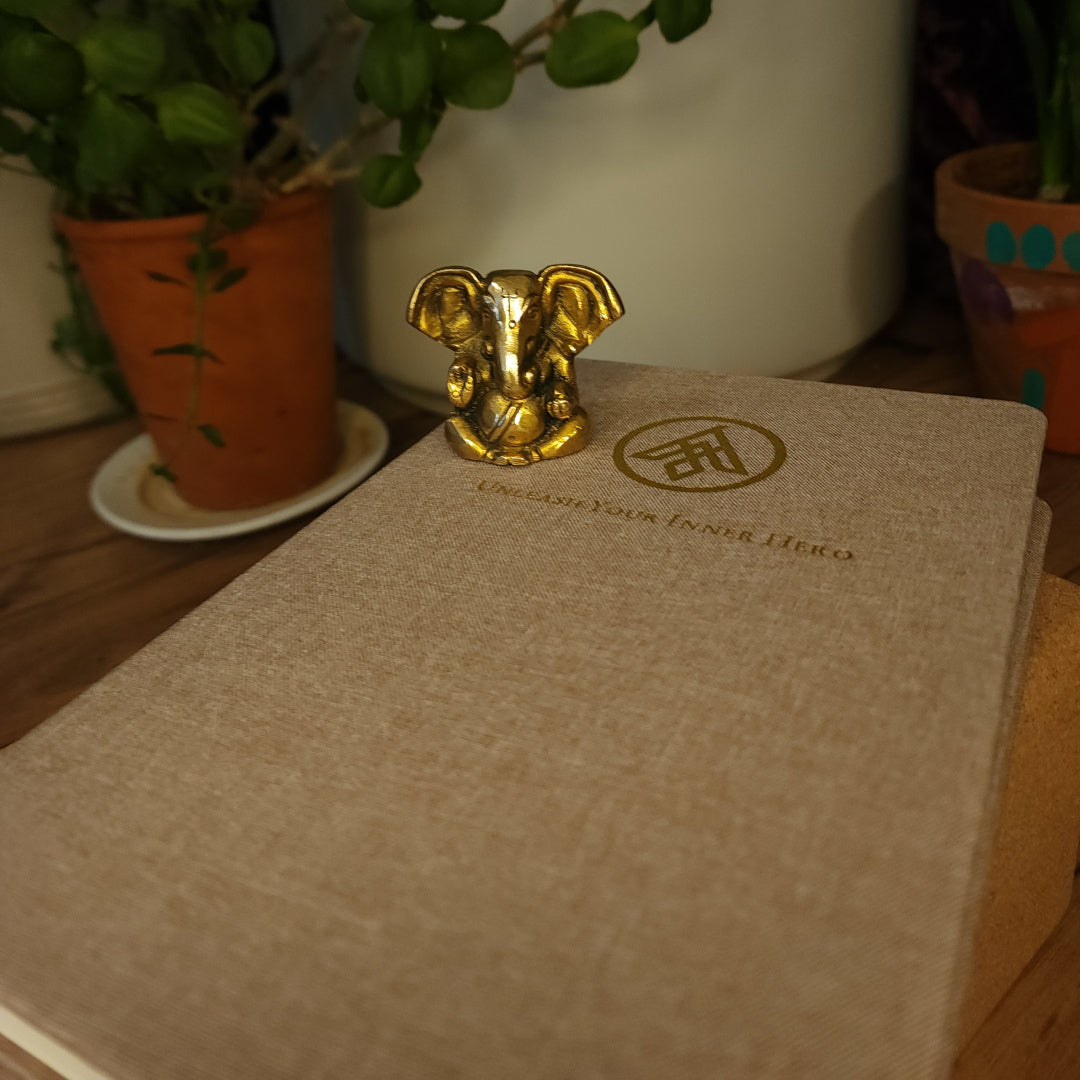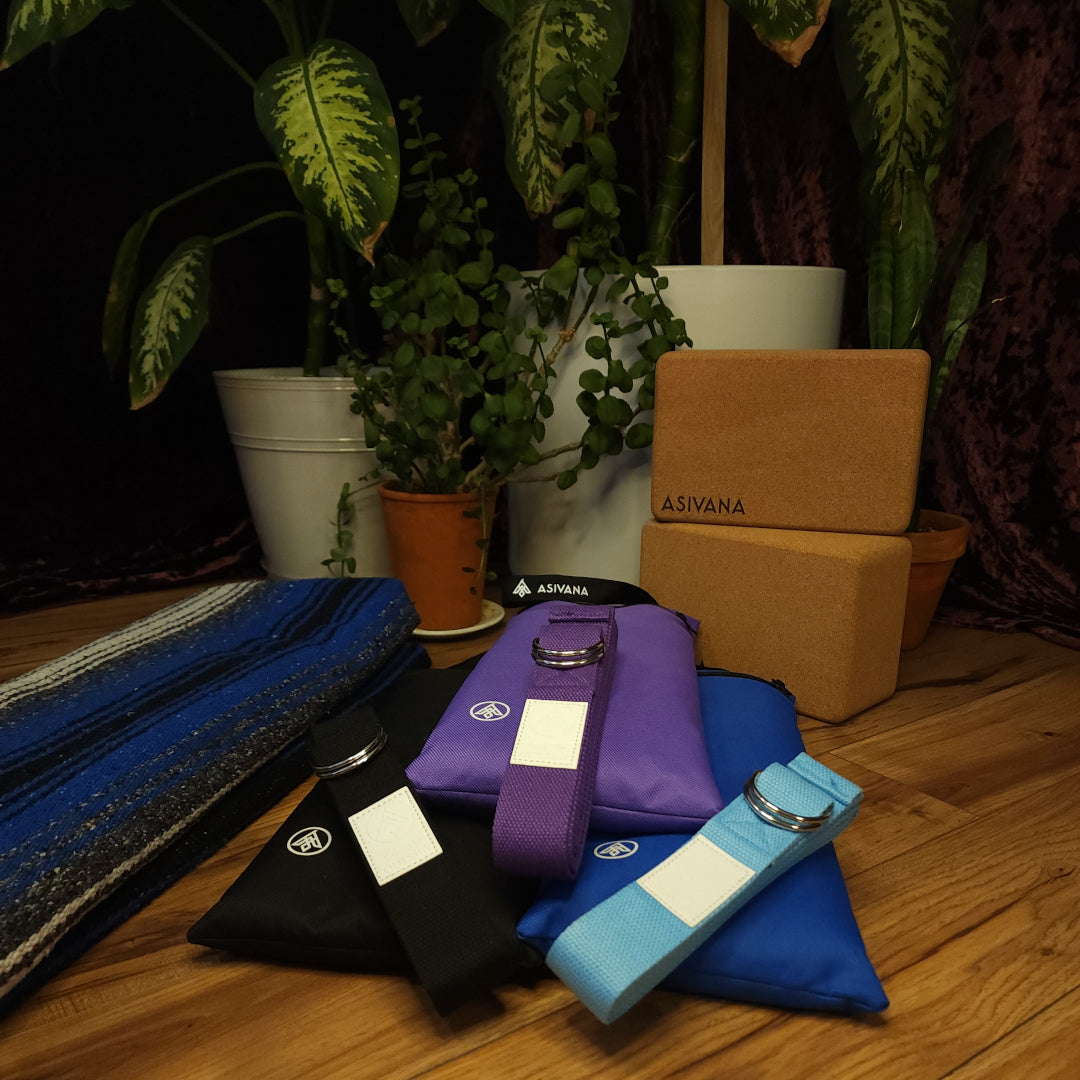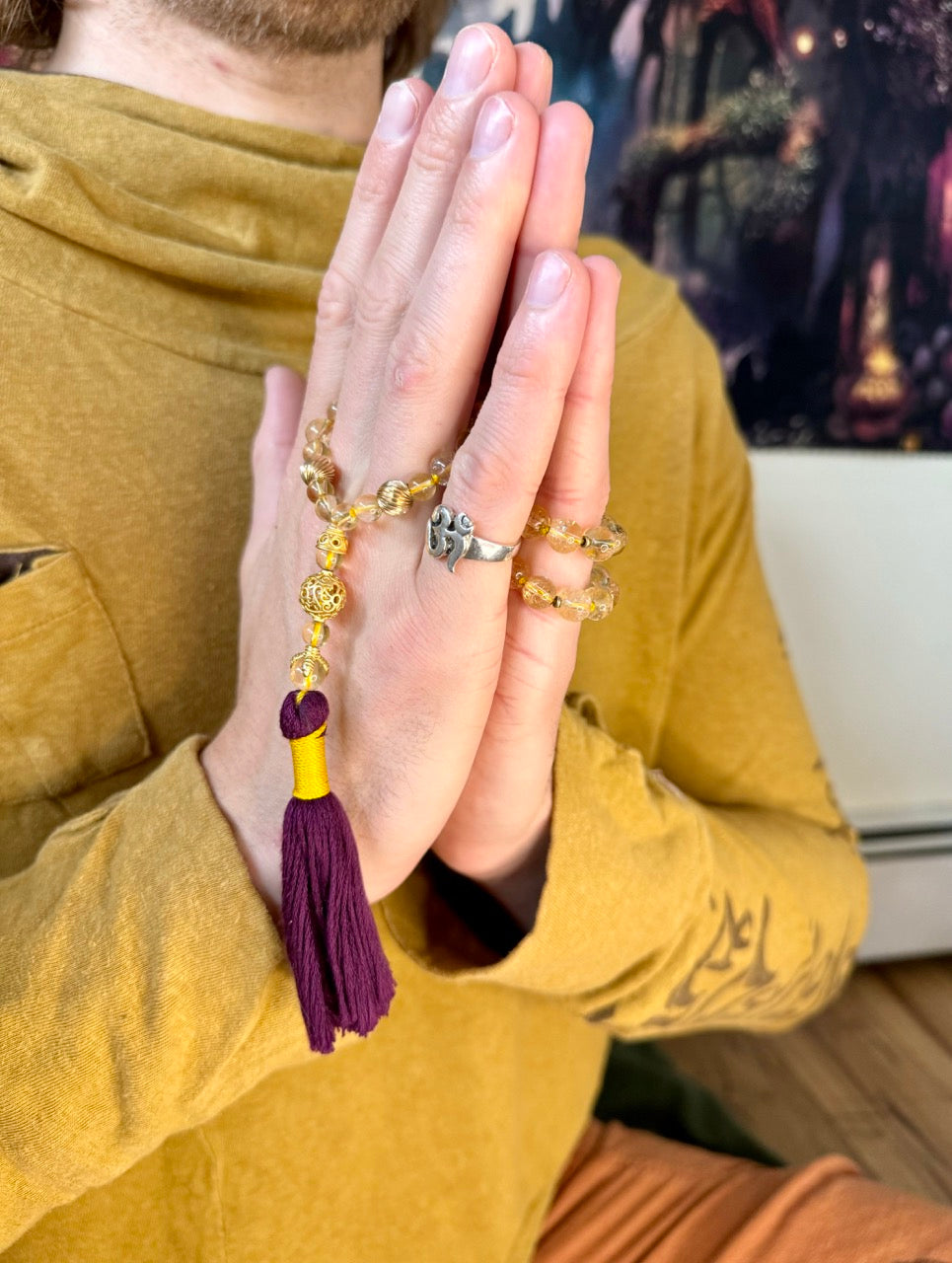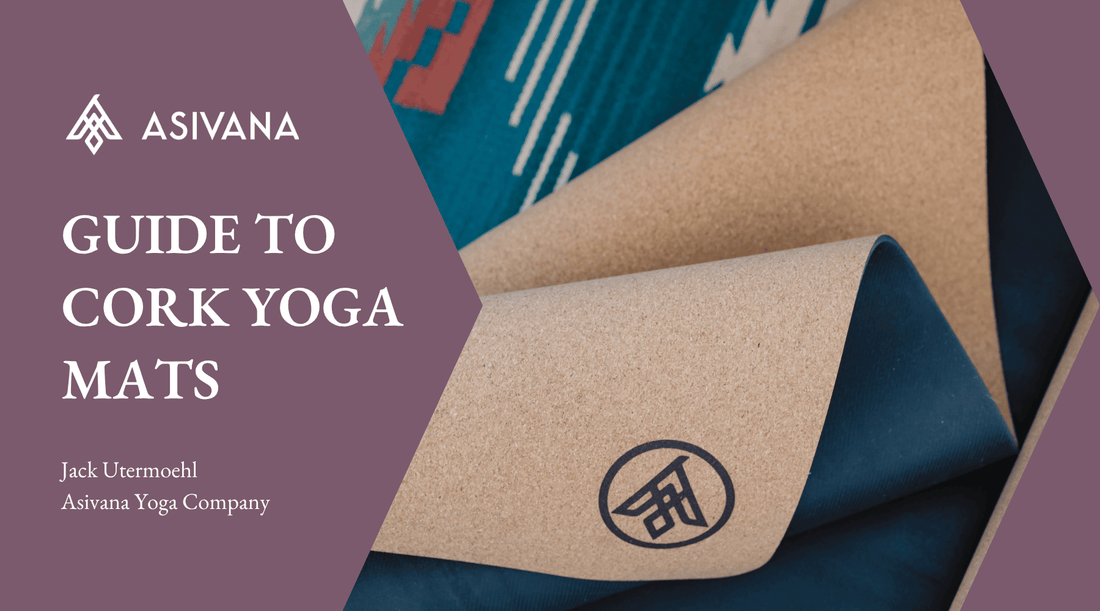
The Ultimate Guide to Cork Yoga Mats
Jack UtermoehlShare
Some mats grip. Others cushion. A few stay clean. Cork does all three—and more.
For years, I cycled through mat after mat. Slippery when wet. Chemical smells. Skin irritation. Nothing felt right. Then I tried cork. I didn’t expect much. But the experience was different. Grounded. Honest. Clean. Functional. I never went back.
Whether you’re deep into your yoga journey or just looking for a mat that actually works, cork deserves your attention. It isn’t hype. It’s biology, sustainability, and subtle psychological support woven into one surface.
What Makes Cork Yoga Mats Different?
Cork isn’t just an eco-marketing trend. It’s a material with real integrity and that matters when you’re trying to build a practice rooted in clarity, not distractions.
Here’s what sets it apart:
- Grips Better with Sweat: The more heat and moisture, the tackier cork becomes. No towel needed.
- Antimicrobial by Nature: Cork actively resists bacterial growth. It stays fresher longer.
- Sustainably Harvested: The bark is removed without cutting down the tree. Cork trees live longer when harvested regularly.
- Natural Feel: The texture underhand feels stable and earthy not like you’re standing on plastic.
It’s one of the rare materials that gets better over time instead of worse. The longer I’ve practiced on cork, the more I trust it.

Why Your Yoga Mat Actually Matters
I used to think a mat was just a surface. As long as it unrolled flat, gripped, and didn’t stink, it was good enough. I was wrong.
The truth is your mat shapes your practice more than you realize. It’s the ground beneath your body, your breath, and your awareness. If it distracts you, slips underfoot, causes microplastics in your body, or causes discomfort, it pulls you away from what matters: the connection within.
Over the years, I’ve had mats that:
- Slid across wood floors mid-flow
- Gave me rashes on my forearms and knees
- Curled at the edges or cracked after a few months
- Felt more like a beach towel than a support surface
Every one of those issues broke my focus. Interrupted my breath. Turned a moment of presence into one of frustration. A cork mat solved those problems immediately and permanently.
Now, I don’t think about my mat when I practice. And that’s the point. It supports me without needing attention. That’s how you know a tool is doing its job.
Health Benefits: Hypoallergenic & Antimicrobial
Yoga is meant to bring ease but the wrong mat can quietly undermine that.
Many synthetic mats contain latex, PVC, or toxic glues. These materials can irritate the skin, leech toxins, and harbor bacteria, especially in warm or humid environments. If you’ve ever left a class with a rash, or rolled out a mat that smelled like chemicals, you’ve already felt this.
Cork works differently.
- Hypoallergenic: It repels dust, dander, and mold which is ideal for sensitive skin or seasonal allergies.
- Antimicrobial: Its surface actively inhibits bacteria and fungus, reducing odor and buildup without chemical cleaners.
For me, switching to cork ended the cycle of skin flare-ups and constant mat maintenance. No matter how much I cleaned my plastic mats, I couldn't get away from skin issues.
I could lie down in savasana without wondering what I was breathing in. I could press into dolphin pose without itching afterward. It was one less thing to worry about and that gave me more space to actually feel.
Environmental Benefits: Biodegradable & Sustainable
If your practice is rooted in mindfulness, it makes sense to practice on something that reflects that.
Cork is one of the most environmentally responsible materials available for yoga mats. It’s harvested from the bark of cork oak trees without cutting them down. In fact, the process supports the tree’s longevity, cork oaks that are regularly harvested can live over 150 years.
- Carbon Sequestration: Cork forests absorb large amounts of CO2, reducing climate impact.
- Biodiversity Protection: These forests support endangered species and prevent desertification.
- Zero Waste: Cork is biodegradable, recyclable, and renewable. Nothing is wasted in the process.
Most cork mats also use natural rubber or eco-certified TPE for the base layer, which adds to their compostability or low environmental impact. Unlike PVC mats that take hundreds of years to break down, cork mats return to the earth without leaving a toxic legacy.
To me, that’s not just good marketing, it’s part of the practice. It’s ahimsa (non-harming) in action. Every time I unroll my mat, I feel that alignment. It matters.
Emotional & Psychological Edge
Not every benefit is physical.
There's a subtle intelligence to cork. The earthy texture. The natural scent. The way it feels under your hands when you settle into stillness. It doesn’t pull attention the way synthetic materials do. It lets you drop in.
This quality of inward turning is central to pratyahara (withdrawal of the senses). Cork seems to encourage that. It reminds the nervous system that it’s okay to soften, to feel, to breathe.
There’s no data point for that. It’s something you sense. A groundedness that supports you emotionally, even when you don’t realize you need it.
For me, cork created an environment of trust. A place to come back to. A space that holds without distracting. That changes the quality of your practice in ways you only notice once they’re gone.

Personal Experiences with Cork
I didn’t start with cork. I arrived at it through trial, frustration, and skin reactions that made me discover I was allergic to even the highest "quality" yoga mats on the market. I spent hundreds of dollars to discover that all plastic mats were a problem.
So I made my own yoga mat.
- No more rashes: My skin could finally breathe.
- Grip without gadgets: Even in a hot class, I didn’t need a towel or spray.
- Confidence in transitions: I stopped holding back out of fear of sliding.
That experience is what led me to design the Flux Cork Yoga Mat. I didn’t want another mat, I wanted the right mat. Something I could trust. Something I could offer to others with confidence.
Elevate Your Mudra Practice
Capture your insights and deepen your connection with our Yoga Journal.
The Materials Behind a Cork Yoga Mat
Cork yoga mats aren’t made from cork alone. They rely on a dual-layer structure combining the natural benefits of cork with a base that provides grip, support, and structure.
Cork (Top Layer): Sourced from the bark of the cork oak tree. Naturally antimicrobial, non-slip, and renewable. It provides the grounding texture your hands and feet connect with.
Natural Rubber (Bottom Layer): Tapped from rubber trees, this dense material keeps the mat in place and adds cushioning without chemicals. It’s heavy, stable, and sustainable.
TPE (Thermoplastic Elastomer): A synthetic alternative that’s latex-free, recyclable, and lighter in weight. Not all TPE is eco-friendly so look for certified, non-toxic versions if choosing this option.
There’s no single “right” formula. What matters is balance. My personal preference is cork over natural rubber for its weight and stability. Some prefer lighter mats for portability, which is where eco-TPE can shine. Just avoid PVC. It’s toxic to produce, hard to recycle, and often the source of that new-mat chemical smell.
Pros & Cons: Is a Cork Yoga Mat Worth It?
Every product has trade-offs. Cork isn’t perfect for everyone but it’s been the best fit I’ve found for most people who value substance over trend.
✔ Pros
- Excellent Grip: Sweat enhances traction. The more active the class, the better the hold.
- Natural Hygiene: Antimicrobial and odor-resistant without chemical treatments.
- Eco-Friendly: Renewable cork + natural rubber means a much lower environmental impact.
- Durable: High-quality cork mats hold up to years of steady use without flaking or cracking.
- Grounding Feel: Earthy texture supports deeper mental focus and presence during practice.
✘ Cons
- Weight: Cork mats with rubber bases are heavier than foam. Not ideal for bike commutes or long walks.
- Cost: Sustainable materials can sometimes cost more up front. But they often save you money in the long run by lasting longer.
- Texture: Some find the surface less sticky than plastic at first though most adjust quickly, and many prefer it.
If you want a mat that supports your body, honors your values, and doesn’t need constant replacing, cork is an investment worth considering.
Care & Cleaning
One of the best parts about cork? It’s practically self-maintaining. You won’t need elaborate sprays, mat washers, or deep scrubs to keep it clean.
Here’s how I care for mine:
- Mix a small amount of mild soap, I personally use tea tree oil, with warm water.
- Wipe the surface with a soft cloth, no harsh scrubbing needed.
- Use a dry towel to remove excess moisture.
- Let the mat air dry completely before rolling or storing.
You might only need to clean it once every few weeks, depending on how often and intensely you practice. Cork naturally resists odors and bacteria so it stays fresher longer than synthetic alternatives.
Storage Tips
- Roll it cork-side out: This prevents edge curling and protects the cork surface.
- Avoid direct sunlight: Too much heat or UV exposure can dry out the cork over time.
- Let it breathe: If you sweat heavily during practice, unroll or hang the mat until it fully dries.
For extra tips on long-term care, see our full Yoga Mat Care Guide.
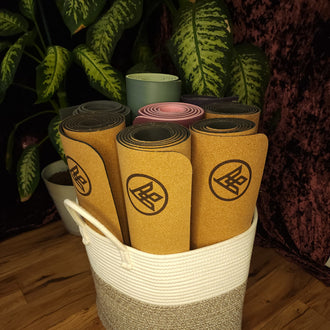
Explore Our Full Collection
Discover all the yoga essentials and accessories you need to enhance your practice. Shop now and elevate your yoga practice.
Shop NowVariations: Sizes, Shapes, & Looks
Not all cork yoga mats are created equal. Beyond the core material, small differences in size, shape, and style can affect your experience.
- Standard Size: Most cork mats measure 72" x 24", with a thickness between 4mm and 5mm enough to protect your joints without feeling squishy.
- Extra-Long: If you're over 6 feet tall or prefer more room, look for mats up to 84" in length.
- Travel Mats: Thinner and lighter options (around 2mm) exist, though they sacrifice cushion for portability.
- Design Options: Cork’s natural tone is a warm, earthy tan. Some brands offer printed designs, alignment markers, or dyed cork. Keep in mind that ink can sometimes alter texture or grip, depending on how it’s applied and the dyes are just gimmick with little real function.
Yoga mat dimensions can vary widely but most studios expect the standard yoga mat size. Unless you're very tall or wide, it could be considered inconsiderate to bring an extra long and/or wide mat to your local studio.
FAQs About Cork Yoga Mats
Is a cork mat good for hot yoga?
Yes. In fact, it’s one of the best options. Cork becomes more grippy with sweat, making it perfect for hot, humid, or high-intensity classes.
Will I slip if I don’t sweat?
Probably not. Cork still provides good dry traction, especially compared to foam or rubber mats. That said, the grip truly shines during active practice.
How long does a cork mat last?
With basic care, years. A well-made cork mat with a solid base layer (like natural rubber) can easily hold up to regular use without cracking, curling, or flaking.
Is cork safe for sensitive skin?
Yes. Cork is hypoallergenic and free from latex, PVC, phthalates, and adhesives that often cause irritation. It’s a great option for anyone with allergies or sensitive skin.
Does cork smell?
Only slightly. Cork has a mild, earthy scent that fades quickly. It doesn’t carry the chemical odor that many synthetic mats do straight out of the box.
Final Thoughts: Why I Recommend Cork
If you want a mat that supports your body, respects the earth, and stays out of the way while you focus on your breath then cork delivers.
It’s not a gimmick. It’s not a trend. It’s a return to simplicity. To groundedness. To trust in natural materials that work in harmony with your practice.
I designed the Flux Cork Yoga Mat for people like me, people who want a mat that feels good, holds up, and doesn’t require a second thought once it’s on the ground.
If that’s what you’re looking for, I believe this is the mat for you.
Yoga invites us to live with more awareness of body, breath, behavior, and impact. A cork mat aligns with that invitation. And over time, you’ll feel the difference.









